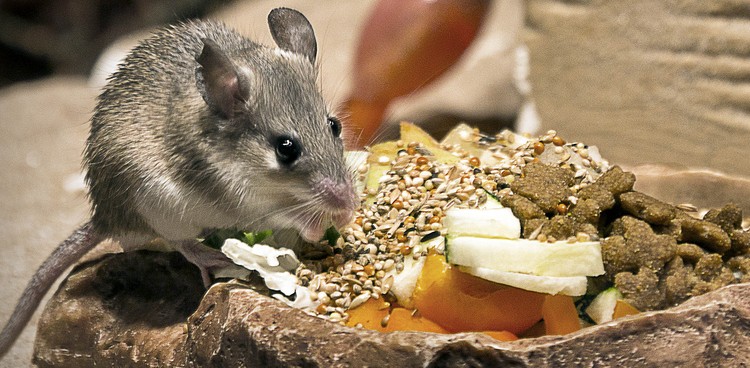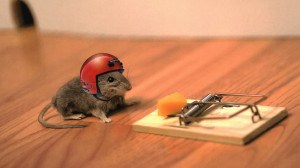
In this blog series, intern Julia explores the everyday language surrounding cheese, from etymology to idioms to associations. Learn why we “say cheese” when we take a photo, why once upon a time we believed that the moon was made of green cheese, or even the history of the word cheese itself. Last week, we learned why some people might say they are “cheesed off”. Plus, be sure to answer the prompt at the end of the post each week for a chance to win a copy of culture’s ultimate cheese pairing guide: Cheese+ Good luck to everyone for this week!
Few things go together as well as mice and cheese. At least, that’s the prevailing image. Endless clip art shows little mice climbing in and around the holes in Swiss cheese. Socks and puzzles and stress toys and countless other products feature the two. A favorite image of mine shows a little mouse, helmet on, prepared to dive onto a cheese-baited mousetrap. The mouse-cheese dynamic is now a trope in media as well. One of the promoted images for Ratatouille shows the main character, Remy, leaping into the air, firmly holding a wedge of cheese as plates explode and chaos reigns behind him (true, he’s a rat, but that just means he can fit more cheese in his belly!). On the Cartoon Network website, the featured game for Tom and Jerry is “The Great Cheese Chase.”And who can forget cheese-loving Gus, the little rotund mouse from Disney’s Cinderella?
In reality, however, you don’t have to worry about mice sneaking into your home and nibbling on your expensive aged cheddar. Neither will a bit of Gouda be a good choice for a mouse trap (although why you would purposefully waste that deliciousness on a mouse is beyond me!). It turns out that cheese doesn’t sit all that well with these little rodents, no matter what television shows, movies, or the Internet try to tell you.
Dr. David Holmes of Manchester Metropolitan University did a study in 2006 about what foods attract or drive off certain animals. For mice, he found that, not only did they not like cheese, but they were actually repelled by some types. Mice have very sensitive noses that are simply overpowered by the strong odors of certain cheeses (Holmes mentions Stilton as an example). In an interview with Scientific American he explained that mice normally target grains or high-sugar foods, and the origin of this myth is certainly puzzling:
“Somewhere, somehow in history…the people have got really [the] strange idea that mice actually do like cheese; and they will try and feed it to their pets, which can be rather damaging. In fact, mice…actually like grain and dried fruits and to some degree they will go for man-made foods that are high in sugar, such as chocolate.”
If mice hate cheese, where did the image of a cheese-loving mouse come from? No one really knows. Holmes did some investigating into the subject and came to the following conclusion: Prior to the common use of air-tight (and mouse-proof) refrigerators, pantries were stocked with things mice did like, grains and fruits, as well as cheese. When hungry mice broke in, sometimes they would eat the cheese for the sake of not starving. The grains would have gone first, however. It seems that artists might be at fault for perpetuating the mice-cheese myth. Holmes says,
“But as far as I can tell, it has become extremely popular because…cartoonists like to draw little segments of cheese with holes in them and little mice’s faces poking out of them. They will admit this and they would say quite simply it’s a really good image, it’s a kind of image we can use and it’s the kind we will continue to use even though we know that mice don’t like cheese.”
I certainly adore the trope of mice sticking their fuzzy, whiskered faces out of an Emmental wedge, or chomping on a piece held in delicate paws, or heroically escaping a mousetrap with their well-earned bit of cheese. Given how applicable and adorable the image is, I don’t see popular culture abandoning it anytime soon, no matter what science says!
There are endless examples of cheese and mice. What’s your favorite pop culture cheese reference, mouse-related or otherwise? Answer in the comments section by April 29, 2014 at 12:00 midnight EDT for a chance to win a copy of our upcoming special issue, Cheese+. Don’t forget to stop by next week, when we’ll be looking at the possibility of the moon being made of cheese!
Featured image by kinojam via Compfight cc






My children have two pet rats. Rats LOVE cheese!
Hmmm, they must have less-sensitive noses then! Out of curiosity, what types do they eat?
My favorite pop culture reference to cheese that the moon is made of cheese in ‘A Grand Day Out’ starring Wallace and Gromit (!!). The idea that their love of cheese was so strong it inspired them to invent and build a rocket that would transport them to the moon so that they could indulge their love of it endlessly is too whimsical for words. And I have to admit, I’m a bit jealous of their culinary adventure!
That’s my dad’s favorite film, so consequently I’ve seen it so many times I have grown to love it too (And funny you should bring it up…my next blog post opens with it!)
(And funny you should bring it up…my next blog post opens with it!)